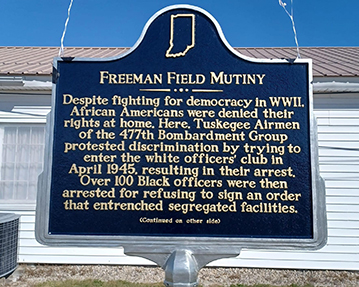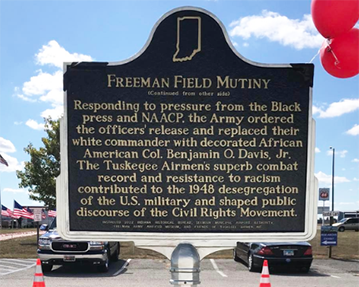

Location: Freeman Army Airfield Museum, 1035 A Ave., Seymour (Jackson Co.) Indiana
Installed 2022 Indiana Historical Bureau, Seymour Municipal Airport Authority, Freeman Army Airfield Museum, and Friends of Tuskegee Airmen, Inc.
ID#: 36.2022.1
Learn more with the Indiana History Blog post: "Blacks Must Wage Two Wars:" The Freeman Field Uprising & WWII Desegregation.
Text
Side One
Despite fighting for democracy in WWII, African Americans were denied their rights at home. Here, Tuskegee Airmen of the 477th Bombardment Group protested discrimination by trying to enter the white officers’ club in April 1945, resulting in their arrest. Over 100 Black officers were then arrested for refusing to sign an order that entrenched segregated facilities.
Side Two
Responding to pressure from the Black press and NAACP, the Army ordered the officers’ release and replaced their white commander with decorated African American Col. Benjamin O. Davis, Jr. The Tuskegee Airmen’s superb combat record and resistance to racism contributed to the 1948 desegregation of the U.S. military and shaped public discourse of the Civil Rights Movement.
Annotated Text
Side One
Despite fighting for democracy in WWII, African Americans were denied their rights at home.[1] Here, Tuskegee Airmen of the 477th Bombardment Group protested discrimination by trying to enter the white officers’ club in April 1945, resulting in their arrest.[2] Over 100 Black officers were then arrested for refusing to sign an order that entrenched segregated facilities.[3]
Side Two
Responding to pressure from the Black press and NAACP, the Army ordered the officers’ release and replaced their white commander with decorated African American Col. Benjamin O. Davis, Jr.[4] The Tuskegee Airmen’s superb combat record and resistance to racism contributed to the 1948 desegregation of the U.S. military[5] and shaped public discourse of the Civil Rights Movement.[6]
[1] Wendell L. Willkie, “Citizens of Negro Blood,” Collier’s Magazine, October 7, 1944, 11, 47, 49, (ISL, Clippings File); “Who’s Guilty?,” The Pittsburgh Courier, April 28, 1945, 6, accessed Newspapers.com; Robert J. Norrell, The House I Live In: Race in the American Century (Oxford: Oxford University Press, 2005), 121; “Civil Rights,” The War documentary series (2007), accessed PBS.org; Henry Louis Gates Jr., “What Was Black America’s Double War?,” The Root (May 24, 2013), accessed theroot.com; Paul Bean, “Tuskegee Airmen at 1940s Hoosier Airfield Played Role in Military Desegregation,” Limestone Post Magazine, October 9, 2018, accessed limestonepostmagazine.com; Black Americans in Congress, “The Second World War,” History, Art & Archives, United States House of Representatives, accessed history.house.gov; “The Double V Victory,” The National WWII Museum, New Orleans, accessed nationalww2museum.org; “Tuskegee Airmen,” Tuskegee Airmen National Historic Site, Tuskegee Institute National Historic Site, accessed National Park Service; Euell A. Nielsen, “The Double V Campaign (1942-1945),” Black Past, July 1, 2020, accessed blackpast.org. Henry Louis Gates, Jr., “What Was Black America’s Double War?,” originally posted on The Root, accessed pbs.org.
[2] “Pilots Defy Segregation at Ind. Camp,” Indianapolis Recorder, April 14, 1945, 1, accessed Hoosier State Chronicles; Charlie Davis, “Offense?—Visiting White Officers’ Club: 477th Bomber Squadron Involved,” The Pittsburgh Courier, April 14, 1945, 1, accessed Newspapers.com; “Army May Move Colonel Selway,” The Pittsburgh Courier, April 28, 1945, 1, 4, accessed Newspapers.com; “Army Officials Chart Future of Bombadiers,” Indianapolis Recorder, April 28, 1945, 1, accessed Hoosier State Chronicles; “April,” The Pittsburgh Courier, December 29, 1945, 2, submitted by applicant; Alan L. Gropman, The Air Force Integrates, 1945-1964 (Washington, D.C.: Office of Air Force History, U.S. Air Force, 1985), 14-26, accessed Defense.gov; Emma Lou Thornbrough, Indiana Blacks in the Twentieth Century (Bloomington, IN: Indiana University Press, 2001), 100; James Allison, “Mutiny at Freeman Field: The Life and the Art of James Gould Cozzens,” Black History News & Notes 92 (Indiana Historical Society, May 2003), 6, submitted by applicant; Dr. Daniel L. Haulman, “Freeman Field Mutiny: Victory for Integration or Segregation?,” Air Force Historical Research Agency (April 2016), 1, 4-5, submitted by applicant; Stories, “The Freeman Field Mutiny,” Tuskegee Airmen National Historic Site, last updated May 13, 2019, accessed National Park Service.
[3] “Group Sent to Kentucky,” The Pittsburgh Courier, April 21, 1945, 1, 4, accessed Newspapers.com; Administrative reprimand of Second Lieutenant Quentin P. Smith, E Squadron (Trainee) by Robert R. Selway, Jr. Colonel, Air Corps, Commanding, April 24, 1945, courtesy of Clanin Collection, M0783, Box 38, Folder 3, Indiana Historical Society; “Army Officials Chart Future of Bombadiers,” Indianapolis Recorder, accessed Hoosier State Chronicles; “Who’s Guilty?,” The Pittsburgh Courier, April 28, 1945, 6, accessed Newspapers.com; “Army May Move Colonel Selway,” The Pittsburgh Courier, April 28, 1945, 1, 4, accessed Newspapers.com; “Along the N.A.A.C.P. Battlefront,” Roy Wilkins, ed., TheCrisis: A Record of the Darker Races (June 1945): 145, accessed Google Books; “Shift of Col. B. O. Davis Causes New Queries,” Indianapolis Recorder, June 30, 1945, 1, accessed Hoosier State Chronicles; Gropman, The Air Force Integrates, 17-26; Rick Callahan, “Tuskegee Airman Returns to Site of Protest,” Indianapolis Star, August 17, 1997, C8, accessed Freeman Field marker file 36.1997.2; Allison, “Mutiny at Freeman Field,” 6; Thornbrough, 100; Ronald E. Franklin, “Tuskegee Airmen History: The Freeman Field Mutiny,” Owlcation, updated January 9, 2018, accessed owlcation.com; Stories, “The Freeman Field Mutiny,” accessed National Park Service.
[4] “Along the N.A.A.C.P. Battlefront,” Roy Wilkins, ed., The Crisis: A Record of the Darker Races (June 1945): 145, accessed Google Books; “Army Officials Chart Future of Bombadiers,” Indianapolis Recorder, April 28, 1945, 1, accessed Hoosier State Chronicles; Gropman, The Air Force Integrates, 24-26; Haulman, “Freeman Field Mutiny,” 4; Joel Hannahs, “Taking a Stand,” World Magazine, February 11, 2012, p. 49, accessed Freeman Field marker file 36.1997.2; Franklin, “Tuskegee Airmen History,” accessed owlcation.com.
[5] “Executive Order 9981: Establishing the President’s Committee on Equality of Treatment and Opportunities in the Armed Services,” signed by Harry S. Truman, The White House, July 26, 1948, accessed Harry S. Truman Library & Museum; Gropman, The Air Force Integrates, 1945-1964, iv, 32, 99; David McCullough, Truman (New York: Simon & Schuster Paperbacks, 1992), 570, 588-589, 651, 971; Amy Wilson, “Indiana was Ground Zero in Tuskegee Airmen’s Fight,” Indianapolis Star, April 22, 2001, D5, accessed Freeman Field marker file 36.1997.2; Mark Newman, The Civil Rights Movement (Westport, CT: Praeger, 2004), 36-37, 39-41, 45-47; Robert J. Norrell, The House I Live In: Race in the American Century (Oxford: Oxford University Press, 2005), 141-143; Haulman, “Freeman Field Mutiny,” 6.
[6] Mark Newman, The Civil Rights Movement (Westport, CT: Praeger, 2004), 33-38, 41-44, 49-50; Robert J. Norrell, The House I Live In: Race in the American Century (Oxford: Oxford University Press, 2005), 123, 127-129, 138-139; Mike Coffey, “Black Fliers Fought Bigotry at Freeman Field,” Seymour Daily Tribune, October 31, 1992, 1, accessed Newspapers.com; Henry Louis Gates Jr., “What Was Black America’s Double War?,” The Root (May 24, 2013), accessed theroot.com; Terrance Bell, “How War Veterans Impacted the Civil Rights Movement,” (U.S. Army, 2017), accessed army.mil; “Birth of the Civil Rights Movement, 1941-1954,” National Park Service, accessed nps.gov; Exhibit, “The Civil Rights Act of 1964: A Long Struggle for Freedom,” Library of Congress, accessed loc.gov; Karen Hodges, “Continuity or Change: African Americans in World War II,” (Teaching American History in Baltimore City), accessed umbc.edu; Bean, “Tuskegee Airmen at 1940s Hoosier Airfield Played Role in Military Desegregation,” accessed limestonepostmagazine.com; Dr. Daniel L. Haulman, “Freeman Field Mutiny,” 1.
Keywords
Military, African American
